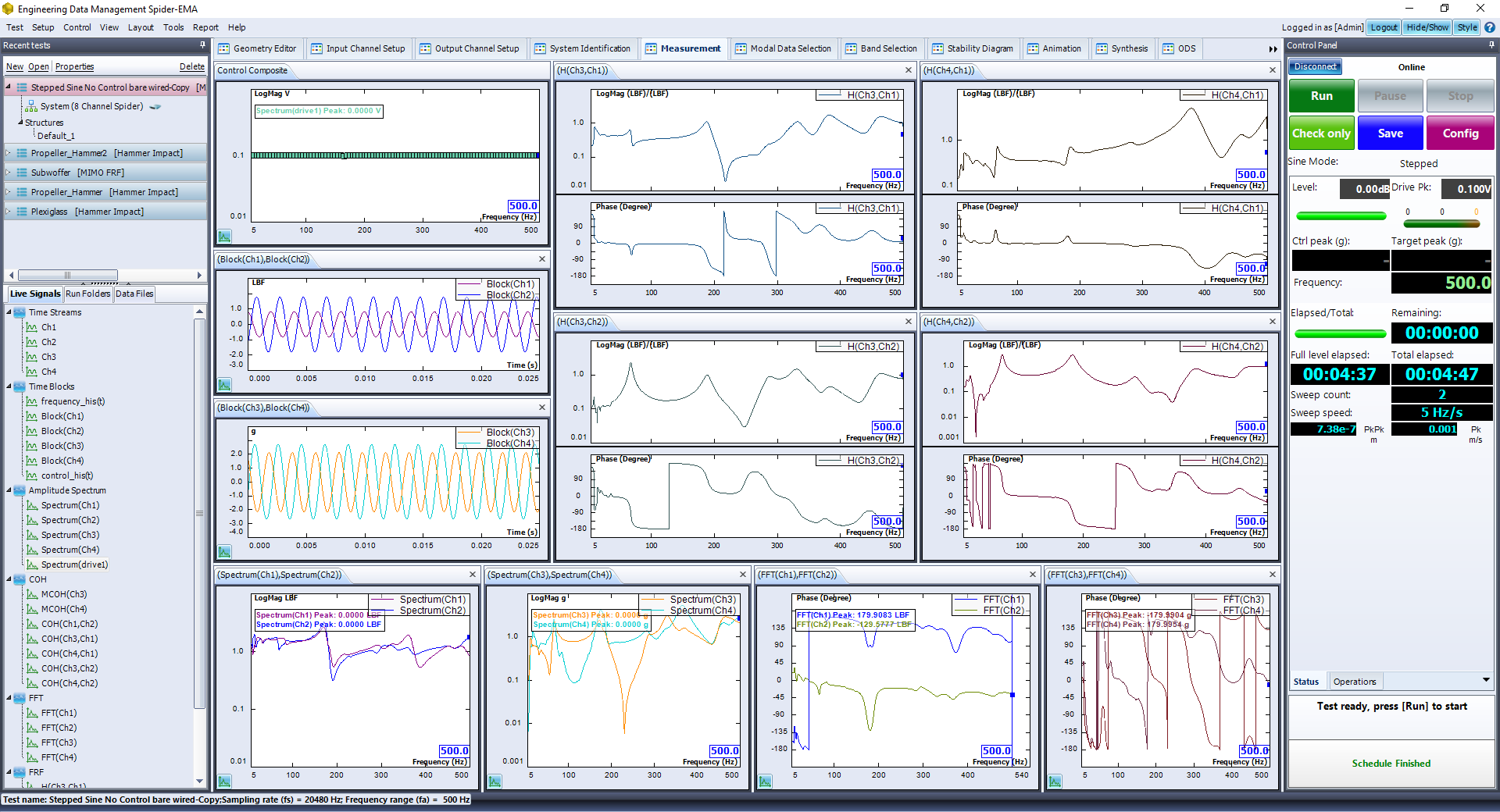MIMO Stepped Sine Testing Technique
The EDM Modal MIMO Stepped Sine Testing option provides multiple Stepped Sine excitations to measure Frequency Response Functions (FRFs). The MIMO Stepped Sine test runs with one frequency at a time, thus providing a high signal-to-noise ratio of sine excitations. The drive voltages can be specified, or input forces are controlled to provide the proper excitation levels for the structure under test. During MIMO Stepped Sine testing, a multiple number of sweeps with different phase conditions are implemented to make the MIMO FRF measurement possible. This process is equivalent to the randomized phase situation of MIMO FRF testing using uncorrelated random excitation methods. An accurate sine tracking filter provides leakage-free response spectra. A system identification step prior to the stepped sine test helps control excitation levels.
The most popular modal testing technique employs broadband random excitation (i.e., Burst Random excitation). After running a random test, MIMO stepped sine testing can be applied by using multiple shakers attached at different locations. Stepped sine excitation is desired due to the nature of the required excitation level for large structures as well as the non-linearity in the structure (e.g., aircraft). When testing these large structures, broadband excitation cannot possibly handle the non-linearity of the structure and testing levels may be too far away from operational vibration levels. The FRFs obtained by sine excitation are of higher quality than the results obtained using random noise excitation.
There are two methods to run the MIMO Stepped Sine test, through use of specified drive profiles or by defining the target responses, more often the required driving forces. The second testing method requires a so-called system identification to first measure the control channels VS drives FRF matrix. With this known and the target profiles defined for the control channels, the required drive signals can be derived.
For the MIMO Sine test, the key to identify the MIMO FRF relies on the multiple number of sweeps, each with a different phase from each output or the control profiles. With this data, the same type of averaging used for MIMO FRF data processing can be performed to derive the MIMO FRF of the structure under test. Due to the high quality of each measurement, the number of sweeps can be less than the number of shakers used for the test.
Now let’s put the MIMO Stepped Sine to the test. Dual modal shakers are connected to drive the plexiglass board while two accelerometers are used to measure the responses. The FRF between these two responses and two excitation forces will be measured.
The following is a MIMO Stepped Sine test result, with the output signal phases as 0, 0; and 0, 180 degrees. The FRF signals are very clean and of high quality after 2 sweeps.
Now, change the phase setting for 2 sweeps to be Random types:
Output 1 Output 2
Sweep 1: 90 11
Sweep 2: 33 117
Run the MIMO Stepped Sine test again, the FRF signals are identical to the previous test.
To verify the results, the MIMO FRF test is also carried out with the same test arrangement using dual modal shakers. Burst Random excitation is used for the test, with the Frequency range at 576 Hz, block size of 4096, and 16 linear averages. The results are shown as follows (the display frequency range is up to 500 Hz, so that the same portion of FRF signals can be compared).
It can be verified that the FRF signals are the same as that from the MIMO Stepped Sine test.
The quality of the MIMO FRF signals from two sweeps equivalent to two linear average of random excitation is very impressive. This confirms that the MIMO Stepped Sine test yields high quality measurements as a result of a high signal to noise ratio in the system. Also, the required number of sweeps is not high at all. The typical number of sweeps is the same as the number of shakers employed.
Complete MIMO FRF data can be acquired after finishing all the measurement points. The modal parameters can be identified using the EDM Modal curve fitting algorithms. The corresponding Mode shapes can be acquired too.
For details regarding the MIMO Stepped Sine modal testing option, please contact Crystal Instruments.



